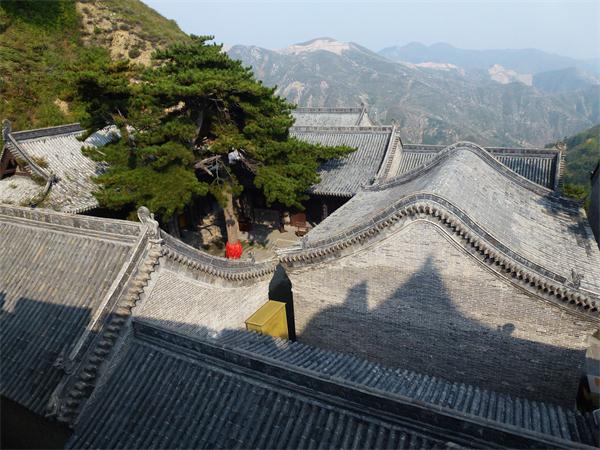Shanxi: The birthplace of China
 |
|
Shanxi city. |
Five years in China sounds a long time but living and working in a country so vast and culturally different from England, time goes quickly. I have toured many parts of China and met people from huge cities and from ethnic minorities but I had not seen much of the province where I live: Shanxi.
Foreigners often research a country that they intend to visit. Unfortunately the information found can be distorted, out of date or simply incorrect. For many foreign people China remains a strange place. For a whole generation this country was restricted to Western people, its culture and development and difficulties shrouded in secrecy or sensationalised in the media.
It is confusing for a foreigner to see the most beautiful places in Shanxi, and wonderful art of such a different style, and square it with an earlier impression that China is backward, dirty and violent with people who are uneducated and fanatical revolutionaries. Where does a foreigner get such ridiculous ideas? Maybe from television and movies or possibly from a man in a pub! I do not judge anything until I have seen for myself. It appears that this province is rich in history, ancient buildings, temples and shrines but its landscapes may be marred by dust and pollution from the open cast mining. Well, now I see for myself.
"I am going to Shanxi," I say.
"But you have asthma. Pollution is bad for your health!"
Well, now I have seen for myself ….. and after 5 years I am alive and well in this beautiful province!
How can information about China be up to date when everything changes so quickly here? What does change slowly is a country's society: its customs, attitudes, traditions and behaviours. Shanxi is perhaps the oldest and most traditional of all the provinces, least affected by Western influence, with Taiyuan at its core.
This area is steeped in history, being the fortress of China, protected by mountains, the Yellow river and the Great Wall. It has ancient buildings not seen anywhere else in China, wrapped safely away from foreign invaders. Shanxi has undisturbed Buddhist, historical and cultural sites full of ancient art dating back over one thousand years.
Foreigners read about Datong as a city covered in gritty dust! There is little mentioned about this city being a garrison walled city since The Ming Dynasty, with tall grey walls and guard towers watching over the area and keeping out enemies beyond the Great Wall. Driving North through one of three archways in the city wall there is a strange feeling of vulnerability even though the city continues on the other side!
At night the wall and towers are beautifully illuminated. There is a courtyard in the city containing a long glazed screen depicting the nine dragons copied the Forbidden City in Beijing. Small clumps of colourful flowers form a delicate contrast to the hard manmade screen. Only a small part of the city wall has yet to be restored. It is interesting to see that common red bricks form the core, then faced with grey brick replicating the original.
I hear that in another province one part of the Great Wall has been covered with concrete! There is much anger about this. Most tourists want to see restorations showing how the original looked. Academics might argue that restoration materials should be clearly different to the original but in Shanxi, Datong workers have succeeded in producing a wonderfully restored part of their history…. and all under a clear blue sky.
Often the first thing to suffer from neglect is a country's art and architecture. With no money more important things are needed, like food! For many years following the Cultural Revolution much artwork was destroyed or deteriorated. Now Shanxi has so much to restore and protect. 1.7 million pounds (1.7 billion yuan) is being spent on restoration projects this year. Shanxi is desperate to develop, which could mean the loss of the province's unique character. Quaint rural villages have disappeared all over China as modern cities spread. Shanxi has a wealth of such habitations dotted among its fields.
Shanxi is the birthplace of China. Along the lifeblood of China, the Yellow River, there is evidence of human habitation thousands of years ago. Bordering with other major Chinese cities Taiyuan and Datong became major centres for commerce. Its position within China gave Shanxi great military significance. It has blossomed into a museum of architecture and history. 2000 years ago Shanxi and the Silk Road opened China to the West. This was to be repeated in 1978 when Deng Xiao Ping opened one city to the west following years of isolation following the revolution. One thing that remained throughout this period was Buddhism with its wealth of art.
So many religions seem to sprout from dreams! There are the dream worlds of the North American Indians and Australian Aborigines, the dreams told about in the Christian Bible and in the Holy Koran. A Han emperor dreamed of a seven foot tall, golden man… interpreted as a command to bring Buddhism to China! Or maybe it was a piece of undigested lamb or too much white wine?
There are other interesting similarities with the West such as wrestling in XinZhou city and in ancient Greece. Both had competitions where the winner receives a goat (or tragos) as a prize. In Greece it was for the best play or poem.
Another similarity is that some Buddhist temples in Shanxi have three doors. One is to go in, one to go out and the middle door is a symbol of nothing or everything. In ancient Greek theatres one door was for actors playing the parts of poor people. Another door was for rich people in a play and the centre door was for actors playing the parts of gods. Like Greece, these places are set in beautiful surroundings. Willow trees grace courtyards, their dainty branches contrasting with white stone statues… and all under the clear blue skies of Shanxi.




















